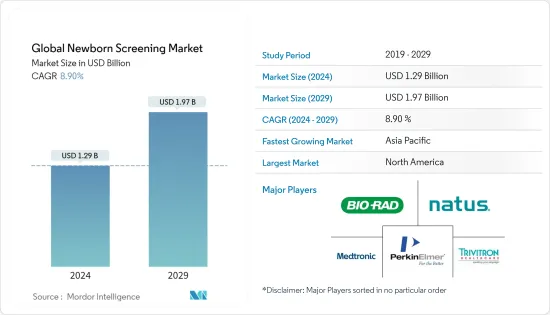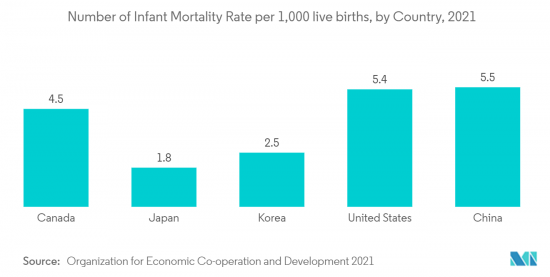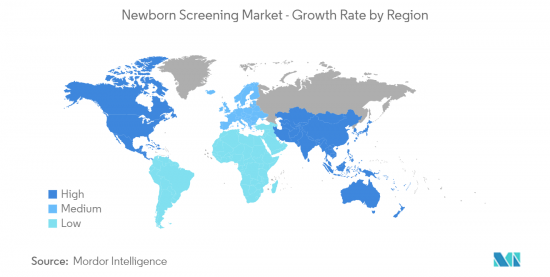
|
市場調査レポート
商品コード
1429227
世界の新生児スクリーニング:市場シェア分析、産業動向と統計、成長動向予測(2024年~2029年)Global Newborn Screening - Market Share Analysis, Industry Trends & Statistics, Growth Forecasts (2024 - 2029) |
||||||
カスタマイズ可能
適宜更新あり
|
|||||||
| 世界の新生児スクリーニング:市場シェア分析、産業動向と統計、成長動向予測(2024年~2029年) |
|
出版日: 2024年02月15日
発行: Mordor Intelligence
ページ情報: 英文 115 Pages
納期: 2~3営業日
|
全表示
- 概要
- 目次
世界の新生児スクリーニング市場規模は、2024年に12億9,000万米ドルと推定され、2029年には19億7,000万米ドルに達すると予測され、予測期間(2024~2029年)のCAGRは8.90%で成長する見込みです。

COVID-19パンデミックは、SARS-COV-2ウイルスの高い感染率に起因するCOVID-19患者の大量流入により、世界中のヘルスケアシステムのあらゆる側面に影響を与えました。また、COVID-19管理に資源が転用されたため、新生児スクリーニング手続きも当初は影響を受けたが、これは市場に影響を与えると予想されます。例えば、2022年3月に発表された「Global impact of COVID-19 on newborn screening programs(新生児スクリーニングプログラムに対するCOVID-19の世界的影響)」と題された調査研究によると、ほとんどの新生児スクリーニングセンターは、パンデミックの影響はほとんどなかった(47.7%)、中程度の影響があった(18.6%)、大きな影響があった(12.8%)と回答しましたが、16.3%のセンターは影響がなかったと回答しました。また、同じ情報源によれば、回答した38カ国中29カ国で、COVID-19は新生児スクリーニング・プログラムに何らかの影響を及ぼし、スクリーニング・センターのほとんどがさまざまな問題に遭遇し、大半はパンデミックの第2波によりマイナスの影響を受けました。したがって、COVID-19は新生児スクリーニング市場に大きな影響を与えると予想されます。
新生児スクリーニング市場の成長要因には、新生児スクリーニングプログラムの拡大、先天性疾患の発生率の上昇、新生児スクリーニングのための政府部門からの資金調達、新生児スクリーニングに使用される技術の進歩などがあります。例えば、2022年4月に発表された「Epidemiology of Congenital Heart Disease in Jinan, China From 2005 to 2020(中国済南市における先天性心疾患の疫学、2005年から2020年まで)」と題された調査研究によると、中国済南市では先天性心疾患の発生率が増加している:A Time Trend Analysis'と題されたデータの時間動向分析によると、都市部では、2005年から2020年にかけて、先天性心疾患(CHD)の有病率は出生1,000人当たり4.81人であったのに対し、農村部では3.17人であり、2005年から2020年にかけて、CHDの有病率は都市部で157.45%、農村部で316.03%それぞれ増加しました。同様に、世界保健機関(WHO)の2022年2月のデータ(推定)によると、出生時の異常は、全世界で毎年生後28日間に約24万人の新生児の死亡の原因となっており、さらに生後1カ月から5歳までの17万人の子供が出生時の異常が原因で死亡しています。したがって、新生児スクリーニングは、新生児の様々な先天異常や病気を判定する上で、新生児の適切な健康分析を提供することができ、新生児に適切な医療措置を提供し、新生児の命を救うために使用することができるため、非常に重要になります。したがって、新生児スクリーニングの需要は増加すると予想され、予測期間中の調査市場の成長を促進します。
さらに、いくつかの政府が退院前の新生児スクリーニングを義務化していることから、大陸各地の政府によって運営されている新生児スクリーニングプログラムは、新生児スクリーニング市場の成長に大きな影響を与えると予想されます。例えば、2021年のMarch of Dimes(MoD)の報告によると、米国では退院前にすべての赤ちゃんが新生児スクリーニングを受けており、毎年約400万人の新生児をスクリーニングしています。さらに、新生児スクリーニングのプラットフォームとデバイスの技術的進歩も、予測期間にわたって新生児スクリーニング市場に大きなプラスの影響を与えると予想されます。しかし、新生児スクリーニングの方針や手順が世界的に統一されていないこと、検査による偽陽性や偽陰性の結果が多いことなどが、予測期間中の新生児スクリーニング市場を抑制すると予想されます。
新生児スクリーニング市場動向
予測期間中、乾燥血液スポットセグメントが市場の主要シェアを占める見込み
COVID-19のパンデミックは、DBS新生児スクリーニング検査に対する大規模な需要を生み出し、パンデミック中の新規NBS検査の開発につながった。2020年7月、PerkinElmer Inc.はGSP/DELFIAプラットフォームを用いたSARS-CoV-2 IgGのドライブラッドスポット(DBS)ベースの検査を発売し、1日当たり最大5,000検体の処理を可能にしました。DBSアッセイはパーキンエルマーのGSPアナライザーで実行され、DELFIAプラットフォームのユニバーサルTRF(時間分解蛍光)と組み合わせることで、32カ国にまたがる世界中の新生児の30%以上をスクリーニングしています。
乾燥血液スポット検査(DBS)は、予測期間中も優位を保つと予想されます。DBSサンプリングは、50年以上にわたって新生児の先天性代謝疾患のスクリーニングに使用されてきました。DBSサンプリングの利点には、必要量が最小であること(1スポットあたり約30~100μL)、指またはかかとスティックによるサンプル採取が容易で、必要なトレーニングが最小限で済むこと、輸送が容易でサンプルが安定することなどがあります。自閉症、リンパ腫、白血病、その他多くの代謝性疾患をこの検査で診断することができます。乾燥血液スポット分析には、少量のサンプルを採取し、容易に運搬できるという利点があります。このように、新生児における疾患の増加が市場の成長を後押ししています。
さらに、このセグメントでは、既存の製品に対抗するために、新しい製品や技術を開発している組織や学術機関がいくつかあります。例えば、2022年3月、オックスフォード大学はテムズ川流域で集団ベースの新生児スクリーニング研究を開始しました。このスクリーニングは、新生児のガスリー・カード(乾燥血液スポット・サンプル)の予備容量を使用し、英国のルーチン新生児血液スポット・スクリーニング経路を通じて行われます。このように、上記の要因は、予測期間中、研究セグメントの成長を促進すると予想されます。

予測期間中、北米地域が市場の主要シェアを占める見込み
北米地域は、同地域における先天性欠損症の高い負担、政府の政策、強固なヘルスケアインフラの存在、同地域を拠点とする企業による新生児スクリーニング技術の新たな技術開拓などにより、新生児スクリーニング市場で大きなシェアを占めると予想されます。例えば、2022年4月に発表された「14歳以前の子どもの死亡率と先天性異常の関連」と題された調査研究によると、先天性異常は循環器、呼吸器、消化器系の原因による死亡率と強く関連しており、この発見は死亡率における先天性異常の役割が過小評価されている可能性を提起しています。この研究はカナダで実施されたもので、同じ情報源によれば、心臓疾患、染色体異常、中枢神経系障害などの先天性異常はすべて、死亡の可能性をそれぞれ10倍以上、8倍以上、17倍以上増加させ、死亡リスクは生後28日目から364日目の間に有意に高かったが、他の時期にも高かったです。したがって、同地域における新生児スクリーニングの需要は時間の経過とともに増加し、同地域の市場は成長すると予想されます。
北米地域では、米国が最大の市場シェアを占めると予想されます。これは、新生児の障害発生率が増加していることと、高度なシステムに対する需要が高まっていることに起因しています。米国では、すべての新生児が出生後にスクリーニングを受け、このスクリーニングは生後2日目にろ紙に採取した血液スポットの診断マーカーを分析することで実施されます。米国では新生児スクリーニング・プログラムは州単位で実施されているため、多くの州の検査パネルに統一性がないことが観察されています。例えば、米国疾病予防管理センターが発表したデータによると、2022年の国内新生児出生数は約3,613,647人、2022年の国内出生率は人口1,000人当たり11.0人で、そのほとんどが病院で出生しているため、スクリーニングは退院前に実施されています。さらに、この地域での新しいサービスや製品の発売は、調査した市場の成長に大きな影響を与えると予想されます。例えば、2021年6月、テキサス州保健福祉局は脊髄性筋萎縮症(SMA)の新生児スクリーニングを開始しました。したがって、上記の要因から、新生児スクリーニング市場は予測期間中に大きな市場シェアを獲得すると予想されます。

新生児スクリーニング業界の概要
新生児スクリーニング市場の競争は中程度で、複数の大手企業で構成されています。市場シェアの面では、現在市場を独占している主要企業は少数です。市場の主なプレーヤーとしては、Agilent Technologies Inc.、Natus Medical Inc.、Trivitronヘルスケア、Medtronic Inc.、Masimo Corp.、Bio-Rad Laboratories Inc.などが挙げられます。
その他の特典:
- エクセル形式の市場予測(ME)シート
- 3ヶ月間のアナリストサポート
目次
第1章 イントロダクション
- 調査の前提条件と市場定義
- 調査範囲
第2章 調査手法
第3章 エグゼクティブサマリー
第4章 市場力学
- 市場概要
- 市場促進要因
- 先天性疾患の負担増
- 新生児スクリーニングのための政府部門からの資金増加
- 新生児スクリーニングに使用される技術の進歩
- 市場抑制要因
- 世界各国における新生児スクリーニングの方針と手順の統一性の欠如
- 偽陽性と偽陰性の結果
- ポーターのファイブフォース分析
- 買い手/消費者の交渉力
- 供給企業の交渉力
- 新規参入業者の脅威
- 代替品の脅威
- 競争企業間の敵対関係の強さ
第5章 市場セグメンテーション
- 技術別
- タンデム質量分析
- パルスオキシメトリー
- 酵素ベースアッセイ
- DNAアッセイ
- その他の技術
- 検査タイプ別
- 乾燥血液スポット
- 聴覚スクリーニング
- 重症先天性心疾患(CCHD)
- その他の検査タイプ
- エンドユーザー別
- 病院
- 診断センター
- その他のエンドユーザー
- 地域別
- 北米
- 米国
- カナダ
- メキシコ
- 欧州
- ドイツ
- 英国
- フランス
- イタリア
- スペイン
- その他欧州
- アジア太平洋
- 中国
- 日本
- インド
- オーストラリア
- 韓国
- その他アジア太平洋地域
- 中東・アフリカ
- GCC
- 南アフリカ
- その他中東とアフリカ
- 南米
- ブラジル
- アルゼンチン
- その他南米
- 北米
第6章 競合情勢
- 企業プロファイル
- AB Sciex
- Bio-Rad Laboratories Inc.
- GE Healthcare
- Masimo Corporation
- Medtronic Inc.
- Natus Medical Incorporated
- PerkinElmer Inc.
- Trivitron Healthcare
- ZenTech SA
- Demant A/S
- Waters Corporation
- Thermo Fisher Scientific
- Hill-Rom Holdings Inc.
第7章 市場機会と今後の動向
The Global Newborn Screening Market size is estimated at USD 1.29 billion in 2024, and is expected to reach USD 1.97 billion by 2029, growing at a CAGR of 8.90% during the forecast period (2024-2029).

The COVID-19 pandemic affected every aspect of the healthcare system around the world due to the high influx of COVID-19 patients owing to the high infectivity rate of the SARS-COV-2 virus. The newborn screening procedures were also impacted initially due to the diversion of resources towards COVID-19 management which is anticipated to have an impact on the market. For instance, according to a research study titled 'Global impact of COVID-19 on newborn screening programs' published in March 2022, most newborn screening centers responded that the pandemic created little effect (47.7%), 18.6% a moderate effect, and 12.8% a lot, while 16.3% of the centers reported no effect. Also, as per the same source, in 29 of the 38 countries that responded, COVID-19 had some effect on the newborn screening programs and most of the screening centers encountered a wide range of issues, and the majority were more negatively impacted by the pandemic's second wave. Hence, COVID-19 is expected to have a significant impact on the newborn screening market.
Factors responsible for the growth of the newborn screening market include growing newborn screening programs, rising incidences of congenital diseases, raising funding from government sectors for newborn screening, and advancements in technologies used in newborn screening. For instance, according to a research study published in April 2022, titled 'Epidemiology of Congenital Heart Disease in Jinan, China From 2005 to 2020: A Time Trend Analysis', in urban regions, the prevalence of congenital heart disease (CHD) was 4.81 per 1,000 births from 2005 to 2020, compared to 3.17 per 1,000 births in rural areas and the prevalence of CHD grew by 157.45% and 316.03%, respectively, in urban and rural areas between 2005 and 2020, according to a time trend analysis of the data. Similarly, according to the February 2022 data of the World Health Organization, an estimate, birth abnormalities are responsible for the death of about 240,000 newborns in the first 28 days of life each year across the glove and an additional 170,000 children between the ages of 1 month and 5 years die because of birth abnormalities. Hence, newborn screening becomes very important as it can provide a proper health analysis of newborns in determining various birth defects or diseases, which can be used to provide adequate medical attention to the newborn and save the life of the newborn. Thus, the demand for newborn screening is expected to increase which will fuel growth in the studied market over the forecast period.
Further, the newborn screening programs run by governments across the continent are expected to have a significant impact on the growth of the newborn screening market as several governments have made newborn screening compulsory before getting discharged from the hospital. For instance, according to the March of Dimes (MoD) report of 2021, before leaving the hospital, every baby in the United States receives newborn screening and the nation screens around 4 million newborns annually. Moreover, the technological advancement in newborn screening platforms and devices is also expected to have a significant positive impact on the newborn screening market over the forecast period. However, the lack of uniformity in newborn screening policies and procedures across the world, and a high number of false positive and false negative results from the tests are expected to restrain the newborn screening market during the forecast period.
Newborn Screening Market Trends
Dried Blood Spot Segment is Expected to Hold the Major Share in the Market Over the Forecast Period
The COVID-19 pandemic has created a massive demand for DBS newborn screening tests, which has led to the development of novel NBS tests during the pandemic. In July 2020, PerkinElmer Inc. launched a dry blood spot (DBS) based test for SARS-CoV-2 IgG using its GSP/DELFIA platform, enabling the processing of up to 5,000 samples per day. The DBS assay runs on PerkinElmer's GSP analyzer and, combined with the universal TRF (time-resolved fluorescence) of the DELFIA platform, screens more than 30% of all newborn babies worldwide, spanning 32 countries.
Dried blood spot tests (DBS) are expected to continue their domination during the forecast period. DBS sampling has been used to screen newborn babies for congenital metabolic diseases for over 50 years. The advantages of DBS sampling include minimal volume requirements (approximately 30 - 100 µL per spot), ease of sample attainment by finger or heel stick with minimal training required, and ease of transport and sample stability. Autism, lymphomas, leukemia, and many other metabolic conditions can be diagnosed through this test. Dried blood spot analysis offers the advantage of collecting a small sample volume, which can be easily transported. Thus, rising diseases in newborns are boosting market growth.
Additionally, few organizations and Academic institutes in the segment have been developing novel products and technologies to compete with the existing products. For instance, in March 2022, Oxford University initiated a population-based newborn screening study in the Thames valley. The screening will be done through the routine United Kingdom newborn blood spot screening pathway, using spare capacity from a newborn's Guthrie card (dried blood spot sample). Thus the factors mentioned above are expected to drive the growth of the studied segment during the forecast period.

North America Region is Expected Occupy Major Share in the Market Over the Forecast Period
The North American region is expected to hold a major share in the newborn screening market owing to the high burden of birth defects in the region, government policies, the presence of robust healthcare infrastructure, and new technological developments in newborn screening technology by the players based in the region. For instance, according to a research study published in April 2022, titled 'Association of Birth Defects with Child Mortality Before Age 14 Years', birth defects were strongly associated with mortality owing to circulatory, respiratory, and digestive causes and the finding raises the possibility that the role of birth abnormalities in mortality numbers may be understated. The study was conducted in Canada and as per the same source, birth defects such as heart problems, chromosomal anomalies, and central nervous system disorders all increased the chance of death by more than ten times, eight times, and seventeen times, respectively, and the risk of death was significantly higher between days 28 and 364 of life, however, it was also higher at other times. Hence the demand for newborn screening in the region is expected to increase over time and the market is expected to grow in the region.
In the North American region, the United States is anticipated to hold the largest market share. This can be attributed to the increasing incidence rates of disorders in newborns and the rising demand for advanced systems. In the United States, every newborn is screened post-birth, and this screening is performed by the analysis of diagnostic markers in blood spots collected on filter paper on the second day of an infant's life. Newborn screening programs are run on a state basis within the United States; therefore, it has been observed that there is a lack of uniformity among the testing panels of many states. For instance, according to the data published by the Centers for Disease Control and Prevention, in 2022, about 3,613,647 new births were reported in the country, and the birth rate in the country 2022 was 11.0 per 1,000 population, and most of these birth in hospitals, thus, the screening is performed before babies' discharge. Further, the launch of new services and products in the region is expected to have a significant impact on the growth of the studied market. For instance, in June 2021, the Texas Health and Human Services launched newborn screening for Spinal Muscular Atrophy (SMA). Therefore, due to the above-mentioned factors, the newborn screening market is expected to have a significant market share over the forecast period.

Newborn Screening Industry Overview
The newborn screening market is moderately competitive and consists of several major players. In terms of market share, few of the major players currently dominate the market. Some of the of key players in the market are Agilent Technologies Inc., Natus Medical Inc., Trivitron Healthcare, Medtronic Inc., Masimo Corp., and Bio-Rad Laboratories Inc., among others.
Additional Benefits:
- The market estimate (ME) sheet in Excel format
- 3 months of analyst support
TABLE OF CONTENTS
1 INTRODUCTION
- 1.1 Study Assumptions and Market Definition
- 1.2 Scope of the Study
2 RESEARCH METHODOLOGY
3 EXECUTIVE SUMMARY
4 MARKET DYNAMICS
- 4.1 Market Overview
- 4.2 Market Drivers
- 4.2.1 Rising Burden of Congenital Diseases
- 4.2.2 Rising Funding from Government Sectors for Newborn Screening
- 4.2.3 Advancements in Technologies Used in Newborn Screening
- 4.3 Market Restraints
- 4.3.1 Lack of Uniformity of Newborn Screening Policies and Procedures Across the World
- 4.3.2 False Positive and False Negative Results
- 4.4 Porter's Five Forces Analysis
- 4.4.1 Bargaining Power of Buyers/Consumers
- 4.4.2 Bargaining Power of Suppliers
- 4.4.3 Threat of New Entrants
- 4.4.4 Threat of Substitute Products
- 4.4.5 Intensity of Competitive Rivalry
5 MARKET SEGMENTATION
- 5.1 By Technology
- 5.1.1 Tandem Mass Spectrometry
- 5.1.2 Pulse Oximetry
- 5.1.3 Enzyme Based Assays
- 5.1.4 DNA Assays
- 5.1.5 Other Technologies
- 5.2 By Test Type
- 5.2.1 Dried Blood Spot
- 5.2.2 Hearing Screening
- 5.2.3 Critical Congenital Heart Defect (CCHD)
- 5.2.4 Other Test Types
- 5.3 By End User
- 5.3.1 Hospitals
- 5.3.2 Diagnostic Centers
- 5.3.3 Other End Users
- 5.4 Geography
- 5.4.1 North America
- 5.4.1.1 United States
- 5.4.1.2 Canada
- 5.4.1.3 Mexico
- 5.4.2 Europe
- 5.4.2.1 Germany
- 5.4.2.2 United Kingdom
- 5.4.2.3 France
- 5.4.2.4 Italy
- 5.4.2.5 Spain
- 5.4.2.6 Rest of Europe
- 5.4.3 Asia-Pacific
- 5.4.3.1 China
- 5.4.3.2 Japan
- 5.4.3.3 India
- 5.4.3.4 Australia
- 5.4.3.5 South Korea
- 5.4.3.6 Rest of Asia-Pacific
- 5.4.4 Middle East and Africa
- 5.4.4.1 GCC
- 5.4.4.2 South Africa
- 5.4.4.3 Rest of Middle East and Africa
- 5.4.5 South America
- 5.4.5.1 Brazil
- 5.4.5.2 Argentina
- 5.4.5.3 Rest of South America
- 5.4.1 North America
6 COMPETITIVE LANDSCAPE
- 6.1 Company Profiles
- 6.1.1 AB Sciex
- 6.1.2 Bio-Rad Laboratories Inc.
- 6.1.3 GE Healthcare
- 6.1.4 Masimo Corporation
- 6.1.5 Medtronic Inc.
- 6.1.6 Natus Medical Incorporated
- 6.1.7 PerkinElmer Inc.
- 6.1.8 Trivitron Healthcare
- 6.1.9 ZenTech SA
- 6.1.10 Demant A/S
- 6.1.11 Waters Corporation
- 6.1.12 Thermo Fisher Scientific
- 6.1.13 Hill-Rom Holdings Inc.


